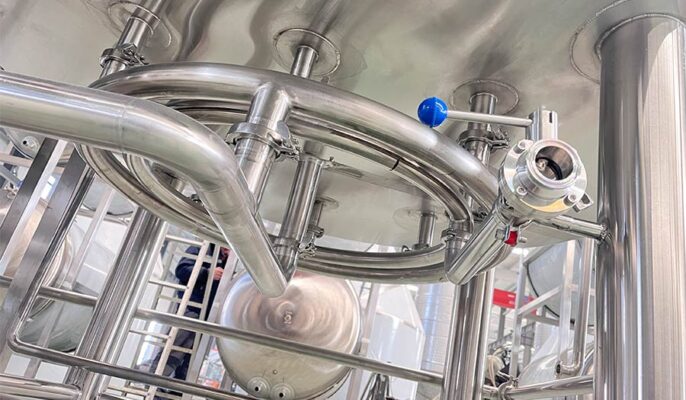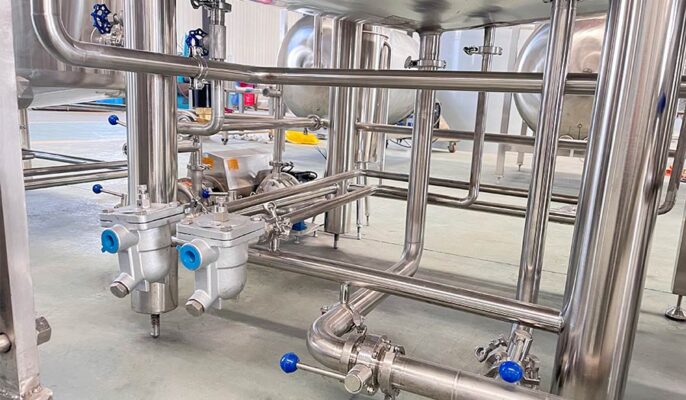Beer brewing production is an industry with diversified equipment, and pipelines are an indispensable and important part of the production process. The interconnection between beer equipment is maintained through pipes, which are as important to beer production as the blood vessels in the human body. The glycol pipe is part of the glycol cooler. It acts on cold glycol water transfer, which usually occurs between glycol water vessels and fermentation vessels/発酵器, coolers, and glycol water storage tanks. Glycol piping is also an important consideration for glycol chillers and glycol air conditioning equipment. So, choosing the right glycol piping for your brewery is crucial.
Piping options used in breweries
- Copper Pipe: Copper pipes outperform other plumbing options strength, durability, and appearance. Although they are more susceptible to corrosion and leaks, they provide even heat transfer and are easy to clean. Copper is more expensive than other types of pipes, but has the highest heat exchange rate and cools the wort faster than stainless steel.
- Stainless Steel: Stainless steel is versatile and can be used in any part of a brewery, including pipes and tanks. Brewing with stainless steel makes cleaning easier because stainless steel can be cleaned with oxygen-containing cleaners. Using stainless steel also means there is less chance of tanks or pipes being dented, scratched, or corroded.
- Black pipes: Black pipes are pipes used to carry water in and out of breweries. Other pipes can be used for this process, but “black pipe” is cost-effective and available.
- Galvanized pipe: Galvanized pipe is a type of steel pipe. They are coated with zinc to help resist corrosion. Over time, but, the zinc reacts to the movement of water and clogs the pipes, causing them to burst. If you use galvanized pipes, make sure they are not exposed to oxygen and are part of a closed system.
- PVC Pipe: PVC (polyvinyl chloride) is the cheapest pipe option. PVC is used in cooling processes, but it reacts with various chemicals. In rare cases, this can cause the pipe to malfunction. PVC is not resistant to high temperatures and is more suitable for small breweries, which do not need the necessary heat required by larger breweries.

Pipe material selection
Which one is more suitable for breweries? The following are stainless steel glycol pipes, PPR pipes, and PPR+PEX hybrid pipes to choose from.
Stainless Steel Glycol Pipe
- Advantages: Long service life. It is both hygienic and rust-proof.
- Disadvantages: Strict space requirements, the area must be the same as the plan, and any type of change requires local welding.
PPR pipe for ethylene glycol pipe
- Advantages: Easy to interact with the device.
- Disadvantages: The adapter between PPR pipes is not rust-proof. It should be covered to prevent contact with water or other liquids.
PPR+PEX mixing tube
- Advantages: Suitable for small sites, and because PEX pipes are flexible, they can be bent in limited areas.
- Disadvantages: Not suitable for systems larger than 1500L.
Pipe diameter selection
The determination of the pipe diameter should be calculated based on factors such as the characteristics of the conveying medium, flow rate, flow rate and fluctuations in the production process, resistance loss, the standard diameter series of the pipeline, etc. should be taken into consideration.
The flow rate of the medium in the process pipeline affects the flow rate under certain conditions. Under the condition of a certain conveying volume, the flow rate determines the diameter of the pipe. Although smaller pipe diameters can be used for higher flow rates, which can save pipeline investment, the resistance loss is large, energy consumption is high, and operating costs are high.
The appropriate flow rate needs to be selected for different medium transportation needs. The flow rate for mash transportation is generally less than 1.5m/s. If it is too high, dextran gel will be formed due to shear force, which will affect the filtration of wort and beer. The feeding speed of the filter tank is less than 1.0m/s. If it is too high, the mash components will separate and the thickness of the defective layer will be uneven. It is more reasonable to choose a lower flow rate and use bottom feeding.
When cleaning and sterilizing pipelines, the flow rate of the cleaning agent and bactericide needs to be greater than 1.5m/s. The flow rate is low and the turbulent scrubbing effect cannot be formed, so the cleaning and sterilization effect cannot be achieved. Achieved. Other common flow rates are generally 1.5-2.5m/s for hot and cold water, 2m/s for sake, 8-15m/s for compressed air or carbon dioxide, and 0.6-1m/s for chilled water.

Pipe smoothness and thickness
The smoothness of the inner wall of the pipeline affects the cleaning and sterilization effect. For the food industry, the cleanliness standard of the internal surface of the equipment should be controlled below Ra<1μm to prevent the accumulation of dirt and bacteria.
The liquid or gas transported by pipelines often has a certain internal pressure, so the pipe wall must have enough strength. For a pipe system made of a certain material, the strength of the pipe depends on the wall thickness of the pipe. The greater the internal pressure of the pipe, the greater the required wall thickness.
Piping design considerations
- The design and layout of pipelines not only affect the cleanliness and beauty of the factory workshop but also affect process operations. Unqualified product quality leads to contamination by bacteria or phages, which will have a certain impact on installation and maintenance. So, the pipeline layout should first meet production needs and process requirements, and help installation, maintenance, and operation management.
- The connecting pipes should be as short as possible and the valves should be as few as possible. Avoid unreasonable arrangements such as pipes moving back and forth on the plane, bending, and twisting on the facade.
- When arranged in layers, large-diameter pipes, heat medium pipes, gas pipes, insulation pipes, and non-corrosive pipes are at the top; small-diameter pipes, liquid, non-insulation, cold medium, and corrosive medium pipes are at the bottom. When the pipes are divided, the gas pipe is led from the top, and the liquid pipe is led from the bottom. Design according to requirements for special circumstances (such as low entrance and high elevation of the fermentation tank refrigerant pipeline).
- For pipelines that are clogged, you can connect a water pipe or a compressed air pipe in front of the valve, change the pipe diameter or reduce the elbow, add a valve near the equipment outlet, or close the pump inlet to the equipment socket, etc.
- Pipes should avoid passing near motors switchboards or both.
- Choose the correct pipe connection. Except that the upper and lower water pipes can be connected by threads, other pipes are best connected by welding and flanges.
- The elevation of the pipe rack should not affect the passage of vehicles and pedestrians. The height between the bottom of the pipe or the bottom of the pipe frame beam and the driving road surface should be ≥ 4.5m; the sidewalk should be ≥ 2.2m; the smallest clearance height of the workshop secondary channel is 2m; the clearance height of the channel under the pipe gallery should be ≥ 3.2m, and if there is a pump, it should be ≥ 4m.
- Drop dead ends in pipes. The so-called dead angle refers to the deviation of the sterilization temperature due to some reason during the sterilization process.
Pipe layout principles
The layout of the pipeline industry should meet the following requirements:
- Meet production and technology needs;
- Easy to operate and maintain;
- No dead corners, convenient for cleaning and disinfection;
- The pipeline layout is beautiful.
Choose a piping solution
Custom piping enables the assembly of a piping system. Micet Group has extensive experience in this area, having installed satisfactory piping systems for breweries around the world. Pre-insulated pipes, high-tech welding solutions, and high-quality stainless steel mean they have energy-efficient systems that last longer than traditional units.




